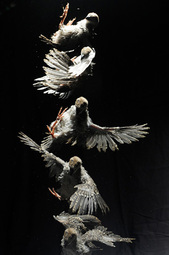IGERT Story
Flapping baby birds offer clues to origin of flight
Description
How did the earliest birds take wing? Did they fall from trees and learn to flap their forelimbs to avoid crashing? Or did they run along the ground and pump their “arms” to get aloft?
The answer is buried 150 million years in the past, but a new University of California, Berkeley, study provides a new piece of evidence – birds have an innate ability to maneuver in midair, a talent that could have helped their ancestors learn to fly rather than fall from a perch.
The study looked at how baby birds, in this case chukar partridges, pheasant-like game birds from Eurasia, react when they fall upside down.
The researchers, Dennis Evangelista, now a postdoctoral researcher at the University of North Carolina, Chapel Hill, and Robert Dudley, UC Berkeley professor of integrative biology, found that even ungainly, day-old baby birds successfully use their flapping wings to right themselves when they fall from a nest, a skill that improves with age until they become coordinated and graceful flyers.
“From day one, post-hatching, 25 percent of these birds can basically roll in midair and land on their feet when you drop them,” said Dudley, who also is affiliated with the Smithsonian Tropical Research Institute in Balboa, Panama. “This suggests that even rudimentary wings can serve a very useful aerodynamic purpose…" Read full article >>
See related publication, “Ontogeny of aerial righting and wing flapping in juvenile birds,” in the Library.






